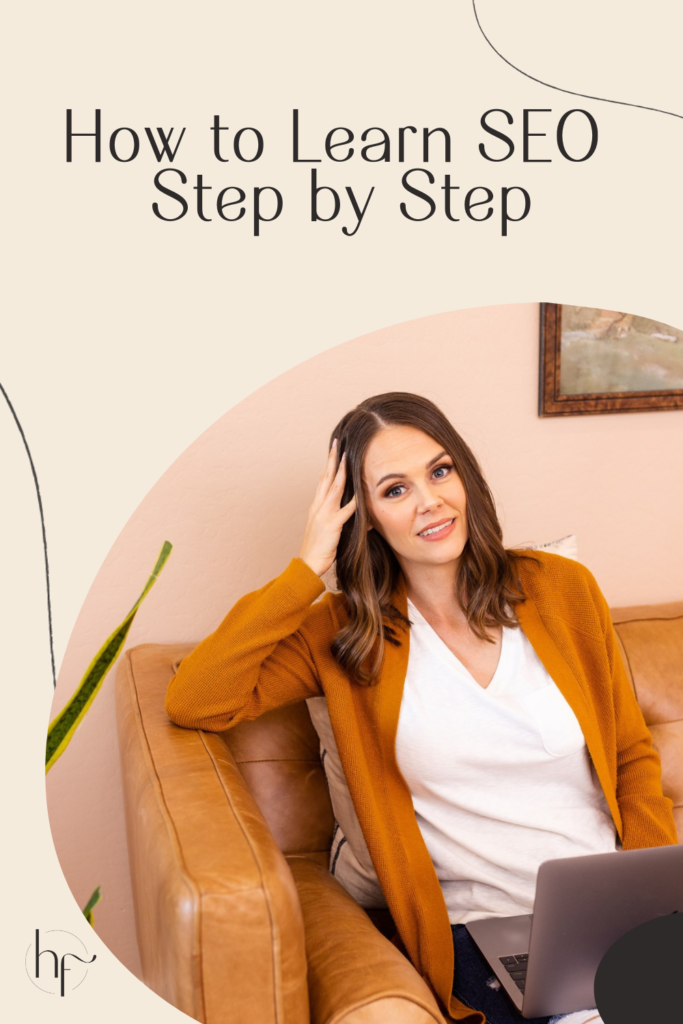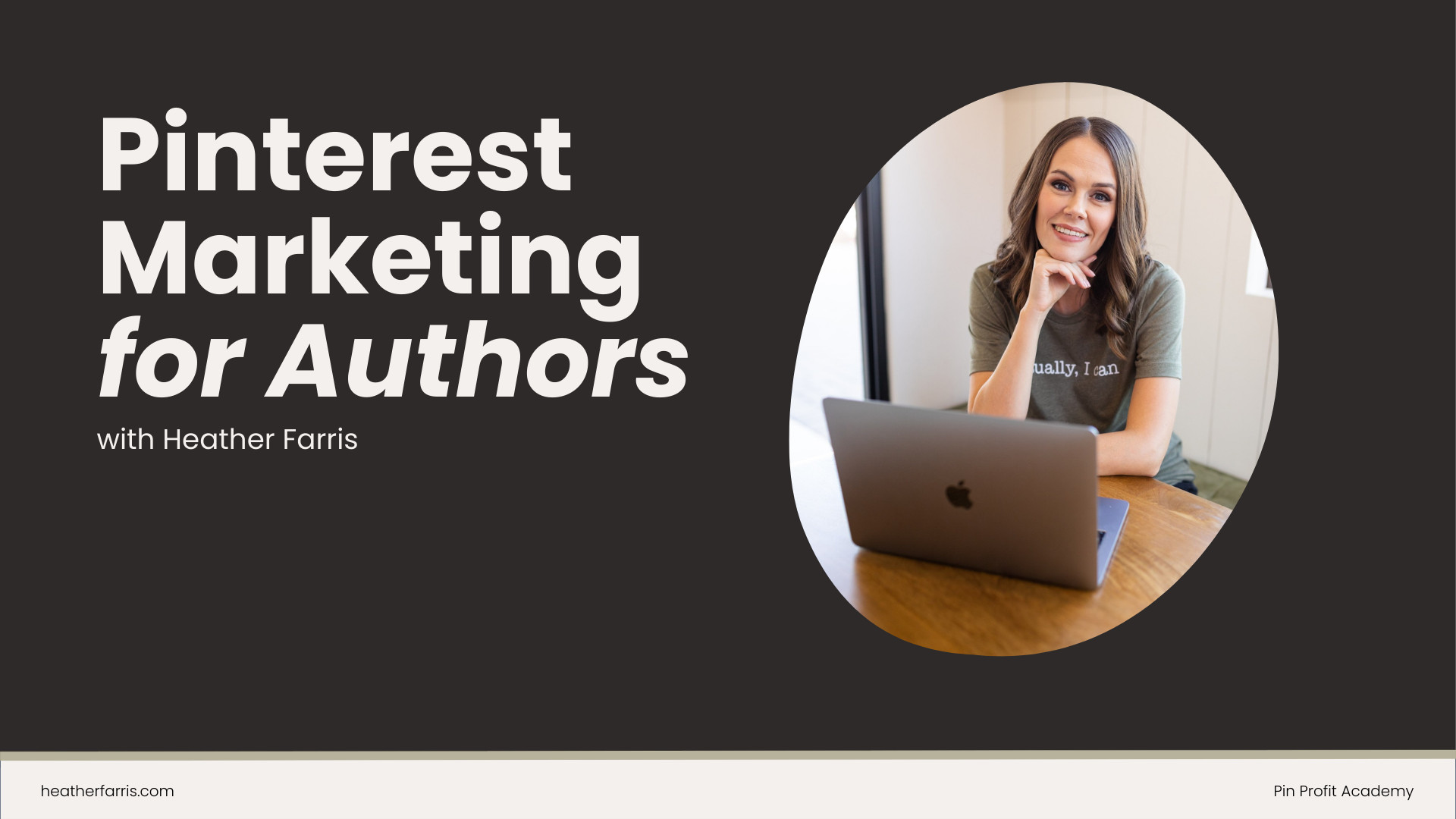Heather is a seasoned
Pinterest marketing expert & educator using the platform since you could reach the bottom of the feed - 2010.
About Heather Farris >
Stupid Simple SEO Review: How to Learn SEO Step by Step
January 30, 2023
Ranking on page 1 of Google doesn’t happen overnight. But when it does, it is so much fun to watch the traffic flow in. So today, we’re going to talk about one of my favorite topics that I hardly ever talk about – Google and how to learn SEO step by step.
I’ve been helping more and more clients in my agency to get better at Google SEO. I have been doing this for a couple of years for my own websites, and I’m seeing some great results now.
I will not show you flashy results of 100,000 page views or ‘I got on media vine.’ That’s not the point of this blog post. The point is to talk about what it takes to rank on page 1 of Google.
I will tell you about the course I took to make that happen for myself. So this is a review of a course I took called Stupid Simple SEO by Mike Pearson, which is 100% worth every dollar you invest.
Here’s how to learn SEO step by step
For those new here, my name is Heather Farris, and I run a Pinterest marketing agency, a YouTube channel, and a paid membership academy. I usually talk all about Pinterest SEO.
It is crucial that you diversify your traffic streams and your income streams because we cannot rely on one single source of traffic or one single source of income. That’s why I’m talking about SEO today and reviewing Mike’s course Stupid Simple SEO, which I took almost three years ago. I have taken it again and again, because it’s just that good.
I will start off by throwing up some screenshots to show you what I’m talking about. So in January 2020, when I rolled into Tucson in my RV, I knew I would start a YouTube channel and thus create more content over the coming months.
I knew because of lessons learned with my two other websites that I needed to focus on SEO and get good at it. That way, I could super speed up my traffic, right? Except I learned that’s not how it works.
RELATED: Pinterest SEO: What Are Your Customers Searching For on Pinterest?
What impacts your ability to rank on Page 1?
These are four things that will impact your ability to rank on page one of Google, at least at the time of this writing in 2023.
#1. Domain authority, domain rating, or domain ranking
Different websites like Moz, Ahrefs, and Semrush will call this term something different. But basically, it’s the score that Google gives your website from 1 to 99, the higher the better. So your domain authority is going to impact how you rank on google.
#2. Search intent
The second thing that will impact how you rank is the search intent behind the keyword and what people meant when searching for it. Google knows what you’re talking about in your content, and they will categorize you properly. So if you’re not using the search intent properly with the keyword people are looking for in your content, you may not rank very well.
#3. Keyword competition
The third thing is the keyword competition itself. If you were going after really high keyword competition phrases, but your domain authority is low, the chances of you actually ranking for that term are slim.
If you’re going to try and rank for a keyword with lower competition, you have a higher likelihood of ranking, even if your domain authority is lower than well established websites.
RELATED: How to Use Keywords to Optimize Your Pins on Pinterest
#4. Covering the topic fully
The fourth thing that a lot of people get lazy with is covering the content topic in full.
- Did you properly research that keyword and that topic and find more than one keyword to cover in that piece of content?
- Did you cover that piece of content fully?
If you didn’t, that could also impact your ranking on Google.
So those are the four things that I think are the biggest impacts, and that’s where we will start with how I applied them on my own website.
Why I chose Stupid Simple SEO
I started offering Pinterest Marketing services in January 2017. It was not until one full year later that I started my website in January 2018. I started Heatherfarris.com, bought the domain, and started creating Pinterest marketing content.
I did not properly optimize my website for SEO until January 2020, when I began creating content for YouTube. At first, I was very haphazard with the YouTube content at that point. I knew I would be more consistent come spring when we finally closed on our house.
So I went ahead and started optimizing my website for SEO. At that time, I had 972 sessions on my website, of which 132 were organic Google Sessions. Not horrible for a 2-year-old website, but not very good.
Now fast forward last week when I outlined this blog, and my website has 2,789 sessions, all of which are organic. My total traffic data is 4241 sessions, and out of that, I have 7278 page views. So I’ve got 4200 total sessions, and more than half of those are organic from Google.
So you can see the growth over time. You can see the work that I have put in. The age of my website also is a factor, and so is the keyword competition and my domain authority, which I have been building. I’ve gone from a domain authority of 7 in January 2020 when I started, and it’s a 40 now, which is inching closer to my biggest competitor in this space.
It takes time. It’s not going to happen overnight, but it can be really fruitful when you put in the work and take the time to hone your SEO skills.
“It’s not going to happen overnight, but it can be really fruitful when you put in the work and take the time to hone your SEO skills.”
That’s where Mike’s course came in for me. I signed up for Stupid Simple SEO in January 2020 and applied it not only for my Heatherfarris.com site but also to my Wheelingtodream.com site, which is my travel blog. I will be doing more with my Whellingtodream come next year.
Changes I made after taking the Stupid Simple SEO course
Let’s talk about Mike’s course and where I started. First of all, I changed the way that I was creating content for my audience. I stopped creating content I thought I wanted to create, and I started creating content that I knew my audience needed and was searching for. I did this based on competitor analysis and competitor research, which Mike does a great job of teaching inside this course.
# 1. Researching my competitors
So one of the homework that I had to do once I took his course was:
- Going and researching my competitors
- Figuring out what keywords they were ranking for
- What their domain authority was
- Honing in on what I could rank for based on that data
It worked really well and can attest to it bringing results.
#2. Creating YouTube videos and blog content
The second thing I changed was I started creating the YouTube content, embedding it into my blog posts, and then creating long-form blog content based on the YouTube video.
I knew I would never be able to do this on my own. I tried to do it on my own for a while, and in late 2020 I hired a content writer. She takes my YouTube videos, and she writes blog posts off them.
I do all of the research and outlining for my YouTube videos based on my competitor analysis, and I put it in a Google doc. It includes all keywords I want to rank for, their competition, and where they all fall. I do a full outline for the YouTube video. Then she takes that information, watches my videos, and writes my content for me. It has just been a dream.
She’s been writing for me for two years now, and there’s an invoice that I pay every single month. I have no problems paying it because it is such a life changer and has changed the traffic I get to my website.
RELATED: Why You Need a Content Strategy Before You Ever Begin Marketing
#3. I’m ranking in the first spot for YouTube videos and blog posts
The third thing that has changed over time is that I actually rank in the first spot for many YouTube videos and blog posts. For example, one of my highest traffic-driving pieces of content is my Canva PSD tutorial. It brings me so much traffic. It’s not exactly Pinterest marketing, but when people get there, they actually start to click around. I can see this in my Google Analytics page flow, which is such a lovely thing.
They’re coming for one thing: to learn how to convert their Canva templates PSD files. They figure out that I talk all about Pinterest marketing, and they start consuming my other content. So that YouTube video and that blog post rank on the top of Page 1. I have just been a hoover vacuum sucking up all that traffic.
RELATED: The Ultimate Pinterest Traffic Strategy for Bloggers & E-Commerce Shops
#4. Creating more long-form content
The fourth thing that has changed is I have started creating more long-form content that fully answers the questions that people are asking related to the topic. I don’t just teach people how to schedule their pins using Tailwind, I also talk about other features related to Tailwind scheduling, or I create a workflow video and lay out all of the details.
I talk about the topic at hand and try to create a full piece of content with a complete picture of that content. Then I embed the YouTube video in it, as I mentioned before, and it works well.
Applying everything I’ve learned
I really began to understand:
- domain authority
- competitor research and analysis
- competitor’s domain authority
- how they were ranking for keywords
- what my audience wanted
- how I could rank for keywords too.
Since I started to understand all of that and implement it, my rankings have really risen, and I have started to grow in traffic.
Now, 7200 page views a month is not a ton. But I make thousands of dollars a month organically from my products now that I sell on my website. And those are all organic sales, so I’ll take it.
The Stupid Simple SEO course is for how to learn SEO step by step?
Let’s talk about the course, what you will learn from it, and for whom it is suitable. When I was outlining this blog, I thought, who is this course good for? Can other people in other industries take advantage of this course?
I’ll be quite honest, not just because I want you to click on my affiliate link and sign up for his free master class. I want you to do that, but I think just about anyone on the Internet creating content can benefit from his course.
- Digital marketing agencies, like myself
- Content creators and bloggers like some of my clients
- Home decor
- Motherhood
- Recipes
- E-commerce stores
He teaches different things in the course that will target and meet you where you are, no matter what you do online. I genuinely believe you can find value in his content if you have any kind of a website or a blog.
This course is not for you if you are unwilling to wait to see the results. This isn’t something that’s like going to flip a switch, and immediately seeing a change in what you’re getting for traffic. It may excite you when you start to see that organic traffic and you start to see the fruits of your labor come to fruition.
Though for me, it took about 13 months to see a considerable difference in the amount of traffic I was getting organically. That is a long time to wait for Google organic traffic, but it’s so good when it does happen.
What does the Super Simple SEO course include?
I want to show you a sneak peek inside the course. That way, you can see a bit of what you’re going to be getting when you go and watch his master class. (Be sure to watch the video above and you’ll be able to see it first hand.)
If you enroll in the course, there are 13 modules. All 13 modules have a lot of videos in them. I think only one of the modules has one video in it. Other than that, the other twelve have 2,4,6,8,10 videos in each module.
This isn’t something that you’re going to consume over a weekend, it will take a couple of weeks. It took me six weeks to get through all of the course materials, and this was only when his course covered Ahrefs as the SEO research tool. His course now covers multiple SEO research tools, including Uber Suggest and some other lower-end keyword research tools like Key Search.
I hope you will, at the very least, sign up for his free master class. It is super value-packed, and I think he will walk away with some things that can change your mind about Google SEO, even if you don’t buy the course.
Course Modules
Module 0. You start with your foundations, where you get your entire workflow setup. Mike then walks you through scaling with SEO.
Module 1. Module one starts with keyword research, which includes undercover keyword research or competitor research. I really love this method because it tells where you stand.
Module 2. In Part 2 of the undercover keyword research, he’s going to walk you through some different tools, analyze your data, and develop your content strategy.
Module 3. From there, he’s going to walk you through a strategic content formula, which is user intense, as I mentioned earlier.
Module 4. Module four is more of the content strategy. It is everything related to outlining your content, long tail keywords, determining your word count, creating content that ranks, internal links, and on-page SEO.
Module 5. Then we move into auditing existing content and deleting content that doesn’t work. He even talks about Pinterest content here.
Module 6. Expertise, authority, and trust are module 6.
Module 7. He talks about backlinks and the whole process of backlinking in this module.
This is where I’ve currently left off because he updated his course in the last six months or so, and I have not watched the newly updated modules,
Module 8. So we move into backlinking and guest posting. These are different ways on top of creating original content that you can begin to grow your domain authority and your links and build your SEO.
Module 9. We move on to blogging for affiliate marketing and ads. There are all kinds of bonuses here, which include:
- scaling with sponsored posts
- site speed for bloggers
- mastering Mediavine ads
- credit takeoff niche site explosion
- site structure mini-class
- low-cost keyword tools
- using Google Search Console
- hiring someone to help you write (like I did)
Module 10. And then there are advanced HR lessons, Ahrefs lessons, etc. I pay for it probably once a year to do a complete keyword analysis and competitor research so that I can stay up to date.
Modules 11 and 12. Advanced link building and How to sell your website.
So that is the gist of this course. You are going to learn everything that you could possibly need and more here.
What is the cost of the Super Simple SEO course?
I don’t know the current pricing of this course, nor do I want to talk about the current pricing because I don’t want this post to be outdated. But I’ll note here what I originally paid for it.
I will always recommend this course. I’ve recommended it for two years. So at the time of recording this, I do believe it’s about $147 a month if you pay on the payment plan. I don’t know how many months the payment plan is, however. When I signed up, it was around $97 a month for four months, and it seriously is worth every single penny now.
Final thoughts on how to learn SEO step by step
If you are ready to take your Google SEO to the next level, click on this link for Stupid Simple SEO, and sign up for his free master class. It is super value-packed.
If you want to learn more on SEO, head on over here and watch the videos where I have talked about Google and how I do keyword research. If you are not ready to invest, these are definitely really great places to start as well.
Pin it for later


Heather Farris went to school for accounting and worked for years in banking and finance. After finding all of that entirely too boring she started her first blog in her basement in August of 2016. She has started 3 blogs in the marketing, motherhood and travel niches and used Pinterest to grow them all. She quickly became the go-to Pinterest strategist in her peer circles and has been implementing strategies, driving traffic and sales through organic and paid tactics for her clients. On this blog and her YouTube channel, as a renowned Pinterest marketing expert, she educates the public about clear and transparent marketing strategies to help them to grow on Pinterest and in other places online as a renowned Pinterest marketing expert.





